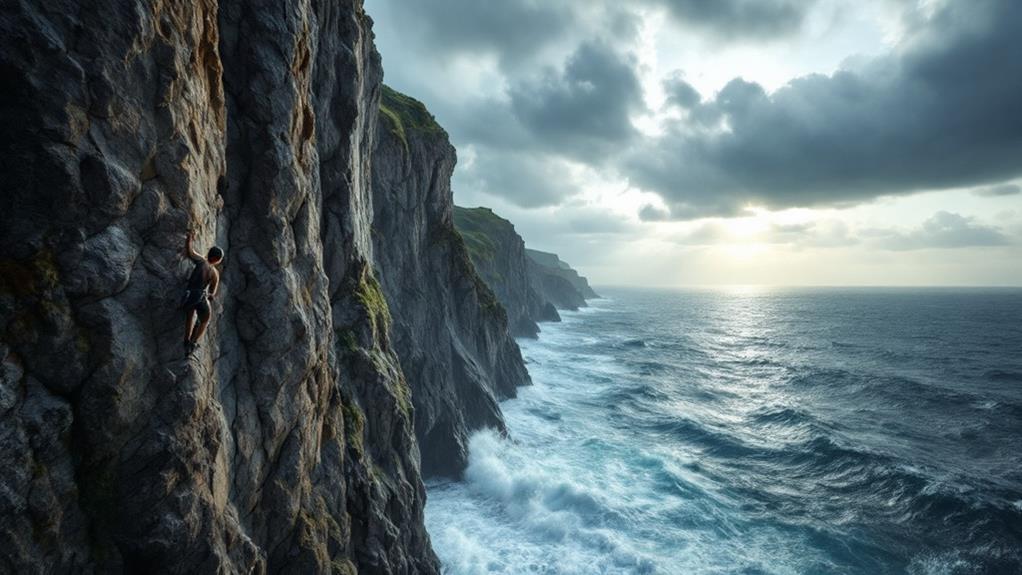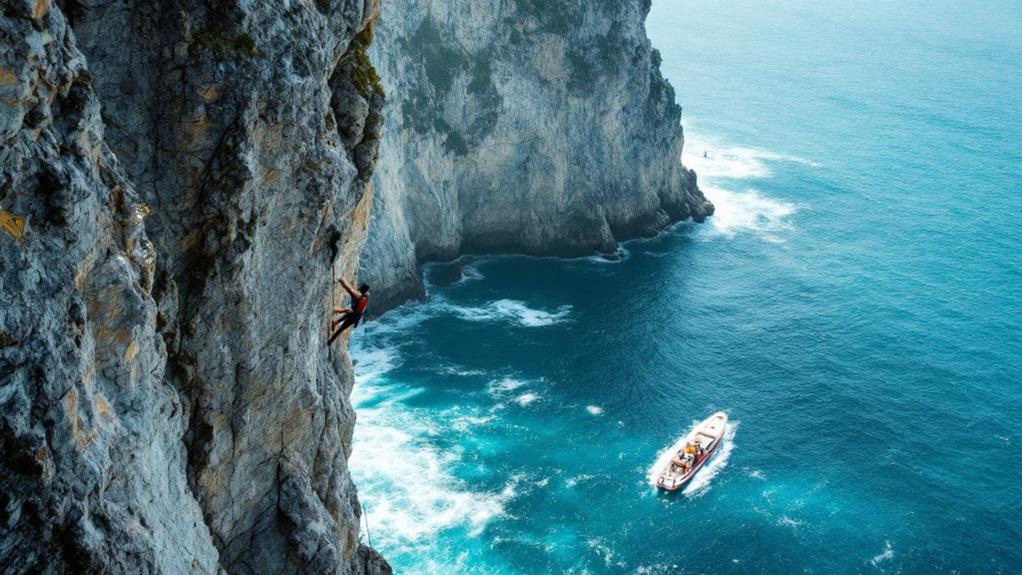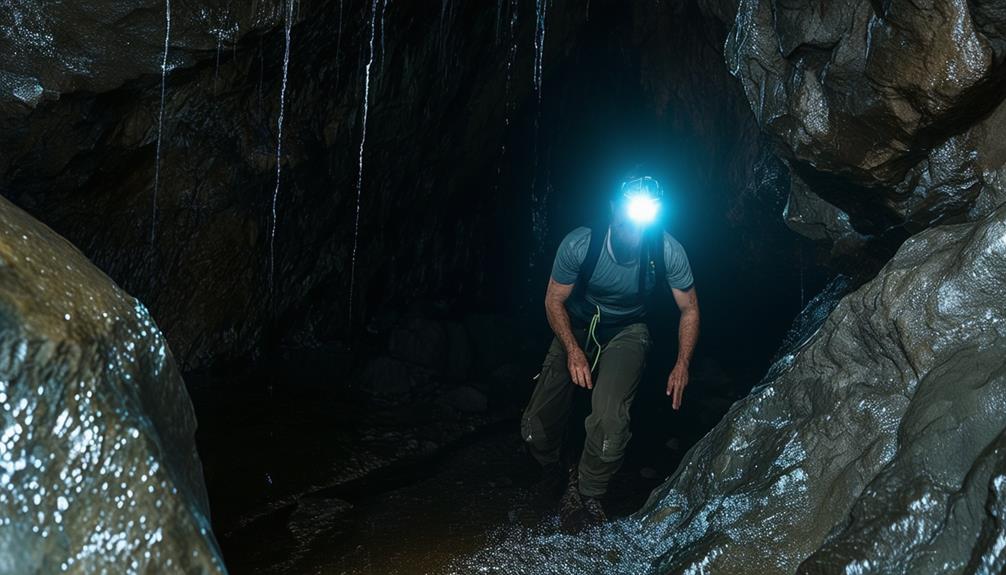How Safe Is Deep Water Soloing?

Deep water soloing isn't inherently safe, but you can minimize risks with proper preparation and skills. You'll face potential high-impact falls, strong currents, and marine life hazards. It's crucial to master water landing techniques, use appropriate gear, and assess environmental conditions. Physical fitness and mental fortitude are essential, as the absence of ropes amplifies psychological challenges. Always climb with a partner, know emergency procedures, and respect local regulations. While thrilling, deep water soloing demands careful consideration of your abilities and the risks involved. Understanding the full scope of challenges and precautions can help you make informed decisions about this exhilarating sport.
Understanding Deep Water Soloing
Deep water soloing, a thrilling branch of rock climbing, involves scaling cliffs or rock faces above deep bodies of water without ropes or harnesses. You'll rely solely on your climbing skills and the water below as your safety net. This form of climbing originated in Mallorca, Spain, and has since gained popularity worldwide.
Unlike traditional rock climbing, deep water soloing eliminates the need for protective gear. You'll climb freely, focusing on the rock and your movements without the distraction of managing ropes or placing gear. The water beneath serves as both your landing pad and your motivation to push your limits.
You'll typically climb routes ranging from 20 to 65 feet high, although some locations offer even taller challenges. The difficulty levels vary widely, catering to beginners and elite climbers alike. As you climb, you'll need to assess the water depth, potential hazards, and your own abilities constantly.
Deep water soloing combines the mental focus of bouldering with the endurance required for longer routes. It's an exhilarating experience that tests your physical and mental strength while offering a unique connection with nature.
Common Risks and Hazards
Danger lurks beneath the surface of deep water soloing's apparent simplicity. Despite its allure, this extreme sport comes with significant risks you must consider. The most obvious hazard is the potential for falls from great heights. Even if you're landing in water, impact injuries can occur, especially if you hit the water at an awkward angle or from a considerable elevation.
Water conditions pose another set of challenges. Strong currents, hidden rocks, or shallow areas can turn a thrilling jump into a dangerous situation. You'll also need to watch out for marine life, as some climbing locations may harbor jellyfish, sea urchins, or other hazardous creatures.
Weather plays a crucial role in deep water soloing safety. Sudden changes in wind or unexpected waves can make climbing and landing more treacherous. Sun exposure and dehydration are additional concerns, as you'll often be climbing in hot, coastal environments without easy access to shade or fresh water.
Lastly, don't underestimate the physical demands of deep water soloing. Fatigue can set in quickly, compromising your judgment and increasing the risk of falls or poor decision-making.
Water Landing Dynamics

Understanding water landing dynamics is crucial for deep water soloing safety. When you fall from a height, the water's surface tension can make it feel like hitting a solid surface. The impact force increases with height and can lead to injuries if you don't enter the water correctly. Extreme sports participants often suffer broken bones, disabilities, or even death, so proper technique is essential.
You'll want to aim for a feet-first entry, keeping your body straight and arms close to your sides. This position helps you break through the water's surface more efficiently and reduces the risk of injury. As you fall, you should exhale to prevent water from rushing into your nose and mouth upon impact.
The depth of the water is also critical. You'll need at least 10-15 feet of water depth for falls from 20-30 feet, with greater depths required for higher climbs. Be aware that water clarity can be deceptive, making it difficult to judge depth accurately.
Wind conditions can affect your fall trajectory, potentially pushing you towards hazards or shallow areas. Always check the landing zone for submerged rocks, boats, or other obstacles before climbing. Remember, even with proper technique, high falls can still result in injuries, so always climb within your skill level.
Equipment and Preparation
While proper falling technique is vital, your equipment and preparation play equally important roles in deep water soloing safety. You'll need to carefully select your gear and plan your climb to minimize risks.
Start by choosing appropriate footwear. Climbing shoes should fit snugly and provide excellent grip on wet surfaces. Don't forget to bring a towel and dry clothes for after your climb.
Here's a quick checklist of essential equipment and preparation steps:
| Equipment | Preparation |
|---|---|
| Climbing shoes | Check weather forecast |
| Chalk bag | Assess water conditions |
| Dry bag | Inform others of plans |
| First aid kit | Warm up thoroughly |
| Sun protection | Study the route |
Before attempting a deep water solo, scout the area for potential hazards like submerged rocks or strong currents. It's crucial to assess the water depth and ensure it's sufficient for a safe landing.
Always climb with a partner and inform someone on land of your plans. Familiarize yourself with local regulations and respect any restrictions in place. By taking these precautions and properly equipping yourself, you'll significantly reduce the risks associated with deep water soloing.
Weather and Environmental Factors

Weather conditions and environmental factors can make or break your deep water soloing experience. You'll need to carefully consider these elements before embarking on your climb. Wind speed and direction are crucial, as strong gusts can throw off your balance or push you away from the wall during a fall. Water temperature is another vital factor; cold water can quickly lead to hypothermia, so you'll want to ensure it's warm enough for prolonged exposure. Ice swimming can enhance the immune system and cardiovascular health, but the cold water also poses severe risks like hypothermia and frostbite.
Tides and currents play a significant role in your safety. You should time your climb with the tides, avoiding high tide when water levels might be too close to the rock face. Strong currents can make it difficult to swim back to shore or your exit point, so check local conditions beforehand. Sun exposure is another consideration; you'll be climbing without a shirt or shoes, so sunburn is a real risk. Apply waterproof sunscreen and consider wearing a hat when not climbing.
Lastly, be aware of marine life in the area. Jellyfish, sea urchins, and sharp coral can pose hazards when you're in the water. Research the local ecosystem and take appropriate precautions to minimize risks from wildlife encounters.
Physical Demands and Training
Deep water soloing demands exceptional physical fitness and mental fortitude. You'll need to develop strength, endurance, and flexibility specific to climbing. Focus on improving your grip strength, core stability, and upper body power. Regular climbing sessions, both indoors and outdoors, will help you build the necessary skills and confidence.
Train your cardiovascular system through activities like running or swimming to boost your overall stamina. Practice falling techniques in controlled environments to prepare for potential water entries. You'll also need to work on your mental game, as deep water soloing requires intense focus and the ability to manage fear.
Proper nutrition and hydration are crucial. Maintain a balanced diet rich in protein, complex carbohydrates, and healthy fats to fuel your climbs. Stay well-hydrated, especially in hot or humid conditions.
Don't underestimate the importance of rest and recovery. Allow your body time to heal between climbing sessions to prevent overuse injuries. Incorporate stretching and mobility exercises into your routine to maintain flexibility and reduce the risk of strains or pulls.
Mental Challenges and Psychology

The mind plays a crucial role in deep water soloing, presenting unique psychological challenges. You'll face fears of falling, height, and water impact, which can be overwhelming. Overcoming these mental barriers requires strong focus and confidence in your abilities.
Visualization techniques and positive self-talk can help you stay calm and centered during climbs. You'll need to manage adrenaline rushes and maintain clear decision-making skills while navigating challenging routes. The absence of ropes and harnesses amplifies the psychological intensity, demanding unwavering trust in your strength and technique.
| Mental Aspect | Challenge | Coping Strategy |
|---|---|---|
| Fear of falling | Hesitation, panic | Controlled breathing |
| Height anxiety | Freezing mid-climb | Focus on immediate moves |
| Water impact | Reluctance to commit | Gradual exposure |
To build mental resilience, start with easier routes and gradually increase difficulty. Practice falling safely to boost confidence. Remember, your perception of risk often exceeds the actual danger. By developing a strong mental game, you'll enhance your deep water soloing experience and push your limits safely. Embrace the mental challenges as opportunities for personal growth and self-discovery in this thrilling sport.
Emergency Procedures and Rescue
Safety nets can't catch you in deep water soloing, so knowing emergency procedures is crucial. You'll need to be prepared for various scenarios, including falls, injuries, and drowning risks. Always climb with a partner who can spot you and call for help if needed. Before you start, scout the area for potential hazards like submerged rocks or strong currents.
If you fall, try to enter the water feet-first with your arms crossed over your chest. Once in the water, assess yourself for injuries and swim to safety. If you're injured, call for help immediately and try to stay afloat. Your partner should be ready to assist or contact emergency services.
Keep essential safety gear nearby, including a first aid kit, throw bag, and communication device. Learn basic first aid and CPR before attempting deep water soloing. Familiarize yourself with local emergency numbers and the nearest medical facilities.
In case of a serious accident, don't attempt a rescue beyond your capabilities. Instead, call for professional help and provide clear information about your location and the situation. Remember, your safety and that of others should always be your top priority.
Legal and Ethical Considerations

While understanding emergency procedures is vital, you'll also need to consider the legal and ethical aspects of deep water soloing. Many popular deep water soloing locations have specific regulations or restrictions. Before you climb, research local laws and obtain any necessary permits. Some areas may prohibit this activity altogether due to environmental concerns or safety risks.
Respect private property and don't trespass. If you're climbing on sea cliffs, be aware of tide times and any maritime laws that might apply. Consider the impact of your actions on the environment. Avoid disturbing wildlife, particularly nesting birds on coastal cliffs. Don't leave any trash behind and minimize your impact on the rock face.
Ethically, you should assess your skill level honestly and avoid climbs beyond your abilities. This reduces the risk of accidents and the need for rescue operations. Be mindful of other climbers and water users in the area. Your actions shouldn't endanger others or disrupt their activities. Finally, consider joining or supporting local climbing organizations that work to maintain access and promote responsible practices in deep water soloing areas.




